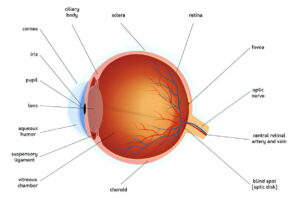
High blood pressure can not only damage the heart but can also have detrimental effects on vision. High blood pressure causes retinal blood vessels to narrow, bleed or even burst due to increased pressure in their system.
Floaters are small dark spots that appear within our field of vision and may resemble dots, circles, lines or cobwebs.
Causes
A floater is a small spot that drifts in and out of your line of vision, often appearing like dots, circles, lines, cobwebs or clouds. They form when the jelly-like substance (vitreous) within your eye liquifies or contracts and causes shadows cast onto the retina – they’re usually harmless parts of normal aging; however, if sudden increases or flashes of light occur they could indicate retinal tears or detachments and should be examined immediately by an eye care specialist immediately.
Posterior vitreous detachment (PVD) is an eye condition in which the jelly-like substance inside your eye shrinks over time and detaches from its attachment point – usually your retina lining the back of your eye – leaving a gap at its centre. Most commonly seen among people over 40. While a PVD may occur naturally, it should still be checked by a healthcare provider as soon as it occurs to avoid serious consequences on vision loss and potential eye infections.
Bleeding into the vitreous can also result in floaters. This may be caused by retinal tears, blocked blood vessels or injury to the eye. Left untreated, these tears could lead to retinal detachments which cause more floaters; for this reason it’s essential that you consult an eye specialist if any symptoms of retinal detachment arise such as new floaters and flashes of light.
Other causes of floaters include cataracts, which is clouding of the lens of the eye that reduces vision and causes blurriness, while another condition called choroidal hemorrhage – bleeding in the fluid of the eye that results in redness, floaters, and loss of vision – can cause them too.
High blood pressure can also contribute to intracranial hypertension, causing tissue swelling in the skull and leading to pain, blurred vision and an irritating “pulsing hammer sensation in your eyes.” To lower your risk of complications related to high blood pressure it’s essential to heeding advice from medical practitioners on lowering it – so be sure to follow their advice for lowering it effectively!
Symptoms
Eye floaters are small clumps or strands of cells or gel that appear to float within a person’s field of vision, often as dots, circles, lines, clouds or cobwebs. Most often seen when looking at blank walls or blue skies. While most often harmless and considered part of the normal aging process, sudden appearance of many floaters, particularly with flashes of light or veiling the vision should prompt immediate consultation with an eye doctor.
Floaters are caused by collagen protein liquefaction in the vitreous humour – the clear jelly-like fluid found inside most eyes that fills most of their space – that forms an invisible thread connecting eye tissues together. When this collagen protein begins to solidify it clumps up into thread-like structures which cast shadows across retina, creating what are known as “floaters.” Certain people experience more floaters than others and as we age they increase in number.
High blood pressure (hypertension) can affect the retina by damaging its blood vessels, leading to symptoms including blurred vision, eye floaters and dark spots in vision; collectively this condition is known as hypertensive retinopathy.
Untreated high blood pressure can damage fragile blood vessels in the retina and cause them to burst and irritate surrounding tissue, leading to vision loss or, in extreme cases, complete blindness.
Blood pressure is one of the greatest risk factors for medical complications, so it’s crucial that it remains under control. You can do this by eating well, exercising regularly and managing stress effectively as well as scheduling regular eye exams – these strategies should all work to bring down blood pressure levels and ensure its prevention.
Floaters can typically be treated by taking medications to regulate your blood pressure. If the cause of high blood pressure cannot be effectively addressed with medication alone, your doctor may suggest making changes in diet or lifestyle to decrease the likelihood of future floaters developing. Overall, the goal should be keeping your blood pressure under control through both means – medications and lifestyle choices combined can have significant effects on both mental and physical wellbeing, so keep an eye on it at all times!
Diagnosis
Floaters are small clumps of gel or cells that float freely within your eye’s vitreous gel-like substance (vitreous). As we age, this substance thickens and shrinks over time, leading to these tiny clumps forming. Although they’re usually harmless and don’t cause vision loss, sudden appearance of large numbers of new floaters could signal retinal detachment that needs immediate treatment; flashes of light or veiling over your vision should prompt immediate consultation with an eye care practitioner.
Most cases of floaters are the result of hemorrhaging in the vitreous, which results in black dots or blobs that appear to float in your field of vision. They may appear scattered or dense and move as you blink your eyes or shift positions; Hemorrhage occurs when either the vitreous swells up and stretches the retinal surface or when blood vessels in the retina rupture and bleed; it also can occur if vitreous liquefies and bubbles form;
Hemorrhages may appear scattered or cobweb-like on either the front of your eye (scattered). Floaters, characterized by series of spots or streaks arranged in an oval formation called Weiss rings, may also appear; these could be indicative of proliferative diabetic retinopathy – the most advanced form of diabetic retinopathy which usually results when blood vessels in your retina bleed and clot.
Vitreous hemorrhages often result in blurry vision and the sensation that one or both eyes is “on fire.” To assess this problem, your doctor may perform an eye exam to detect any retinal tears or detachments and perform a fundus exam with dilation drops to assess your vision. Imaging tests such as an ocular ultrasound or fluorescein angiography test may also help confirm diagnosis and pinpoint its source.
If you are living with high blood pressure, taking steps to regulate it could greatly decrease the risk of damage to eyes and other parts of the body. Regular visits with an eye doctor and primary care physician are essential in keeping hypertension under control.
Treatment
High blood pressure is widely recognized as an imminent risk to overall health, but it can also have detrimental repercussions for eye health. Hypertension damages the delicate blood vessels within the retina, narrowing or even rupturing them and leading to symptoms like floaters and blurred vision. With proper control and regular eye exams this damage may often be avoided.
Floaters are small clumps of gel or protein that float within your clear jelly (vitreous humour). They may appear in various forms – specks, dots, cobwebs or even wavy lines that seem to move across your field of vision – more visible against plain or dark backgrounds; most cases of floaters are harmless and should fade over time.
Uncontrolled high blood pressure can damage the retina, leading to hypertensive retinopathy – which may include symptoms like floaters and blurry vision – in untreated individuals. As long as this condition goes untreated, more damage is done over time – in some instances even leading to detached retinas! Luckily, hypertensive retinopathy can be prevented with proper blood pressure management and annual eye exams.
Blocked blood vessels may also lead to new, fragile blood cells leaking into the vitreous jelly that fills most of your eyeball, leaving visible black splotches in your field of vision that result in vitreous haemorrhages – small haemorrhages may resolve themselves over weeks or months, while larger ones could compromise vision altogether and require surgical correction.
Macular oedema can also contribute to floaters in your field of vision, caused when fluid from damaged blood vessels seeps into the macula and collects there, creating blurry vision and floaters at its centre. While treatment options such as medications or laser therapies are available, ultimately treating blocked blood vessels will yield the best results.












